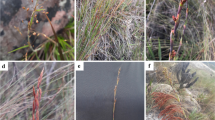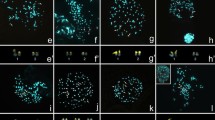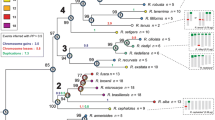Abstract
Homalolepis was described by Turczaninow in 1848 and reestablished by Devecchi et al. in 2018, enclosing mostly the extra-Amazonian species previously included in two sections of Simaba Aubl.. We performed the first cytogenetic analysis in Homalolepis and, by surveying chromosome numbers of other Simaroubaceae representatives, reconstructed the evolution of chromosome numbers in the family, using ChromEvol software. The four Homalolepis species showed 2n = 32 and two or four CMA+ bands. In situ hybridization showed a diverse distribution of ribosomal DNA sites (5S and 18S), positioned on the same chromosome pair in H. floribunda (A. St.-Hil.) Devecchi & Pirani or on different chromosome pairs in H. arenaria (Devecchi & Pirani) Devecchi & Pirani. The basic chromosome number here indicated for Simaroubaceae is x = 12, from which chromosome numbers of other genera were derived by ascending dysploidy, with polyploidy occurring in Ailanthus Desf. only. Homalolepis presents x = 16, derived by ascending disploidy.


Similar content being viewed by others

References
Apples R, Morris R, Gill BS, May CE (1998) Chromosome biology. Kluwer Academic Publishers, Boston
Baratakke RC, Patil CG (2010) Cytological investigations in poly-gamo-dioecious tree Simarouba glauca DC. Nucleus 53:33–36. https://doi.org/10.1007/s13237-010-0008-7
Barros e Silva AE, Soares Filho WS, Guerra M (2013) Linked 5S and 45S rDNA sites are highly conserved through the subfamily Aurantioideae (Rutaceae). Cytogenet Genome Res 140:62–69
Bawa KS (1973) Chromosome numbers of tree species of a lowland tropical community. J Arnold Arbor 54:422–434
Bennetzen JL, Ma J, Devos KM (2005) Mechanisms of recent genome size variation in flowering plants. Ann Bot 95:127–132. https://doi.org/10.1093/aob/mci008
Bernardello LM, Stiefkens LB, Piovano MA (1990) Números cromosómicos en dicotiledóneas argentinas. Bol Soc Argent Bot 26:149–157
Clayton JW (2011) Simaroubaceae. In: Kubitzki K (ed) The families and genera of vascular plants, vol 10. Springer, Berlin, pp 408–423
Clayton JM, Fernando ES, Soltis PS, Soltis DE (2007) Molecular phylogeny of the tree-of-heaven family (Simaroubaceae) based on chloroplast and nuclear markers. Int J Plant Sci 168:1325–1339
Clayton JW, Soltis PS, Soltis DE (2009) Recent long-distance dispersal overshadows ancient biogeographical patterns in a pantropical angiosperm family (Simaroubaceae, Sapindales). Syst Biol 58:395–410. https://doi.org/10.1093/sysbio/syp041
Cronquist A (1981) An integrated system of classification of flowering plants. Columbia University Press, New York
Darlington CD, Wylie AP (1955) Chromosome atlas of flowering plants, 3rd edn. George Allen and Unwin, London, UK
Desai S (1960) Cytology of rutaceae and simaroubaceae. Cytologia 25:28–35. https://doi.org/10.1508/cytologia.25.28
Devecchi MF, Thomas WW, Pirani JR (2018a) Taxonomic revision of the neotropical genus Homalolepis Turcz. (Simaroubaceae). Phytotaxa 366:1–108
Devecchi MF, Thomas WW, Plunkett GM, Pirani JR (2018b) Testing the monophyly of Simaba (Simaroubaceae): Evidence from five molecular regions and morphology. Mol Phylogenetics Evol 120:63–82. https://doi.org/10.1016/j.ympev.2017.11.024
Devecchi MF, Pirani JR, Thomas WW (2020) Simaroubaceae in Flora do Brasil 2020. Jardim Botânico do Rio de Janeiro. Available at: http://floradobrasil.jbrj.gov.br/reflora/floradobrasil/FB604257. Accessed on: 02 Apr. 2021
Funabiki K (1958) Distribution and polyploidy of angiosperms. II Northern Flora of Japan Kromosomo 37:1268–1275
Ghosh R (1970a) Karyomorphological studies of somatic chromosomes in Ailanthus excelsa Roxb., an ornamental and a road-side plant. Broteria 39:3–8
Ghosh R (1970b) An analysis of the somatic chromosomes in Quassia amara L. with some remarks on its taxonomic status and affinity. Broteria 39:9–15
Gill BS, Bir SS, Singhal VK (1979) IOPB chromosome number reports LXV. Taxon 28:627–637
Glick L, Mayrose I (2014) ChromEvol: assessing the pattern of chromosome number evolution and the inference of polyploidy along a phylogeny. Mol Biol Evol 31:1914–1922. https://doi.org/10.1093/molbev/msu122
Guerra M (2000) Chromosome number variation and evolution in monocots. In: Wilson KL (ed) Monocots: Systematics and Evolution. CSIRO, Melbourne, pp 127–136
Guerra M (2008) Chromosome numbers in plant cytotaxonomy concepts and implications. Cytogenet Genome Res. 120:339–350. https://doi.org/10.1159/000121083
Guimarães RGS (2018) Estudos citotaxonômicos em Sapindales: estado da arte e evolução dos números cromossômicos. Universidade Estadual de Campinas, Campinas, Dissertação de Mestrado
Guimarães RGS, Forni-Martins ER (2021) Chromosome numbers and their evolutionary meaning in the Sapindales order – an overview. Braz J Bot (this issue)
Khosla P (1978) Cytosystematics of some hardwood families. Nucleus 21:211–218
Kitamura S, Inoue M, Shikazono N, Tanaka A (2001) Relationships among Nicotiana species revealed by the 5S rDNA spacer sequence and fluorescence in situ hybridization. Theor Appl Genet 103:678–686. https://doi.org/10.1007/s001220100643
Kumari S, Saggoo MIS, Kaur J (1989) SOCGI plant chromosome number reports VIII. J Cytol Genet 24:179–183
Majovsky J (1970) Index of chromosome numbers of Slovakian flora. Acta Fac Rerum Nat Univ Comen, Bot 16:1–26
Mangenot S, Mangenot G (1957) Nombres chromosomiques nouveaux chez diverses Dicotyledones et Monocotyledones d’Afrique occidentale. Bull Du Jard Bot’état Brux 27:639. https://doi.org/10.2307/3666891
Mangenot S, Mangenot G (1962) Enquête sur les nombres chromosomiques dans une collection d’espèces tropicales. Bull Soc Bot Fr 109:411–447. https://doi.org/10.1080/00378941.1962.10838117
Mayrose I, Barker MS, Otto SP (2010) Probabilistic models of chromosome number evolution and the inference of polyploidy. Syst Biol 59:132–144. https://doi.org/10.1093/sysbio/syp083
Mehra PN (1976) Cytology of Himalayan hardwoods. Sree Saraswaty Press Ltd., Calcutta
Mehra PN, Khosla PK (1969) IOPB Chromosome number reports XX. Taxon 18:213–221
Mendes S, Moraes AP, Mirkov TE, Pedrosa-Harand A (2011) Chromosome homeologies and high variation in heterochromatin distribution between Citrus L. and Poncirus Raf. as evidenced by comparative cytogenetic mapping. Chromosome Res 19:521–530. https://doi.org/10.1007/s10577-011-9203-x
Mendes S, Régis T, Terol J, Soares Filho WS, Talon M, Pedrosa-Harand A (2020) Integration of mandarin (Citrus reticulata) cytogenetic map with its genome sequence. Genome 63:437–444. https://doi.org/10.1139/gen-2020-0046
Mesquita AT, Romero-da Cruz MV, Azevedo ALS, Forni-Martins ER (2019) Chromosome number and genome size diversity in five Solanaceae genera. Caryologia 72:105–115. https://doi.org/10.13128/caryologia-772
Moraes AP, Mirkov TE, Guerra M (2008) Mapping the chromosomes of Poncirus trifoliata Raf. by BAC-FISH. Cytogenet Genome Res 121:277–281. https://doi.org/10.1159/000138897
Moraes AP, Barros F, Simões AO, Alayon D, Forni-Martins ER (2016) Detecting mechanisms of karyotype evolution in Heterotaxis (Orchidaceae). PLoS ONE 11:e0165960. https://doi.org/10.1371/journal.pone.0165960
Moran R, Felger R (1968) Castela polyandra, a new species in a new section: union of Holocantha with Castela (Simaroubaceae). Trans San Diego Soc Nat Hist 15:31–40
Murin A, Majovsky J (1978) IOPB chromosome number reports LXI. Taxon 27:375–392
Nakajima G (1942) Cytological studies in some flowering dioecious plants, with special reference to the sex chromosomes. Cytologia 12:262–270. https://doi.org/10.1508/cytologia.12.262
Pathak GN, Singh B (1949) Chromosome numbers in some angiospermous plants. Curr Sci 18:347
Pirani JR, Majure LC, Devecchi MF (2021) An updated account of Simaroubaceae with emphasis on American taxa. Braz J Bot (this issue)
Qiu F, Ungerer MC (2018) Genomic abundance and transcriptional activity of diverse Gypsy and Copia long terminal repeat retrotransposons in three wild sunflower species. BMC Plant Biol 18:1–8. https://doi.org/10.1186/s12870-017-1223-z
Rambaut, A. (2018) FigTree v. 1.4.4 Available at http://tree.bio.ed.ac.uk/software/figtree
Roa F, Guerra M (2012) Distribution of 45S rDNA sites in chromosomes of plants: structural and evolutionary implications. BMC Evol Biol 12:225
Roa F, Guerra M (2015) Non-random distribution of 5S rDNA sites and its association with 45S rDNA in plant chromosomes. Cytogenet Genome Res 146:243–249. https://doi.org/10.1159/000440930
Romero-da-Cruz MV, Forni-Martins ER, Urdampilleta JD (2017). In: Marhold K, Kucera J (ed). IAPT/IOPB Chromosome data 24 – Capsicum parvifolium, Solanaceae. Taxon 66: 277 (printed version), E16-E17 (online extended version)
Schubert I, Lysak MA (2011) Interpretation of karyotype evolution should consider chromosome structural constraints. Trends in Genet 27:207–216. https://doi.org/10.1016/j.tig.2011.03.004
Schwarzacher T, Heslop-Harrison P (2000) Practical in situ hybridization. Springer, New York
Schweizer D (1976) Reverse fluorescent chromosome banding with Chromomycin and DAPI. Chromosoma 58:307–324
Silva SC, Marques A, Soares Filho WS, Pedrosa-Harand A, Mirkov TE, Guerra M (2011) The Cytogenetic Map of the Poncirus trifoliata (L.) Raf. - A nomenclature system for chromosomes of all citric species. Trop Plant Biol 4:99–105. https://doi.org/10.1007/s12042-011-9072-7
Silva SC, Mendes S, Soares Filho WS, Pedrosa-Harand A (2015) Chromosome homologies between Citrus and Poncirus the comparative cytogenetic map of mandarin (Citrus reticulata). Tree Genet Genomes 11:811. https://doi.org/10.1007/s11295-014-0811-4
Singhal V, Gill B (1990) Chromosomal studies in some members of Anacardiaceae. J Cytol Genet 25:36–42
Stace CA (1991) Plant taxonomy and biosystematics, 2nd edn. Cambridge University Press, Cambridge
Stace CA (2000) Cytology and cytogenetics as a fundamental taxonomic resource for the 20th and 21st centuries. Taxon 49:451–477
Takhtajan A (1980) Outline of the classification of flowering plants. Bot Rev 46:226–359
Tobe H (2011) Embryological evidence supports the transfer of Leitneria floridana to the family Simaroubaceae. Ann Mo Bot Gard 98:277–293
Turczaninow NS (1848) Decades quarta et quinta. Generum adhunc nom descriptorum. Bull Soc Imp Nat Moscou 21:570–591
Urdampilleta JD, Souza AP, Forni-Martins ER, Schneider DRS, Vanzela ALL, Ferrucci MS (2009) Molecular and cytogenetic characterization of an AT-rich satellite DNA family in Urvillea chacoensis Hunz. (Paullinieae, Sapindaceae). Genetica 136:171–177
Urdampilleta JD, Coulleri JP, Ferrucci MS, Forni-Martins ER (2012) Karyotype evolution and phylogenetic analyses in the genus Cardiospermum L. (Paullinieae, Sapindaceae). Plant Biol 15:868–881. https://doi.org/10.1111/j.1438-8677.2012.00679.x
Vaio M, Nascimento J, Mendes S, Ibiapino A, Felix LP, Gardner A, Emshwiller E, Fiaschi P, Guerra M (2018) Multiple karyotype changes distinguish two closely related species of Oxalis (O. psoraleoides and O. rhombeo-ovata) and suggest an artificial grouping of section Polymorphae (Oxalidaceae). Bot J Linn Soc 188:269–280
Webster G, Miller K (1963) Chromosomes and relationships of Leitneria. Am J Bot 50:638
White TJ, Bruns T, Lee S, Taylor JW (1990) Amplification and direct sequencing of fungal ribosomal RNA genes for phylogenetics. In: Innis MA, Gelfand DH, Sninsky JJ, White TJ (eds) PCR protocols: a guide to methods and applications. Academic Press, New York, pp 315–322. https://doi.org/10.1016/b978-0-12-372180-8.50042-1
Acknowledgements
This study was financed in part by the Coordenação de Aperfeiçoamento de Pessoal de Nível Superior-Brasil (CAPES)—Finance Code 001, Conselho Nacional de Desenvolvimento Científico e Tecnológico (CNPq) and Fundação de Amparo à Pesquisa do Estado de São Paulo (FAPESP—Grants # 2014/18002-2 and # 2016/06572-4). The authors thank Espaço da Escrita—Pró-Reitoria de Pesquisa—UNICAMP—for the language services provided.
Author information
Authors and Affiliations
Contributions
Conceptualization: ERFM, MVRC and JRP; Methodology: ERFM, MVRC, MFD and RG; Formal analysis and investigation: ERFM, MVRC and RG; Writing—original draft preparation: ERFM, MVRC and RG; Writing—review and editing: all authors; Funding acquisition: ERFM and JRP; Supervision: ERFM. All authors have read and approved the final version of the manuscript.
Corresponding author
Ethics declarations
Conflict of interest
The authors declare that they have no conflict of interest.
Additional information
Publisher's Note
Springer Nature remains neutral with regard to jurisdictional claims in published maps and institutional affiliations.
Rights and permissions
About this article
Cite this article
Romero-da-Cruz, M.V., Guimarães, R., Devecchi, M.F. et al. Chromosome numbers in Homalolepis Turcz. and their significance in Simaroubaceae evolution. Braz. J. Bot 45, 93–101 (2022). https://doi.org/10.1007/s40415-021-00729-5
Received:
Revised:
Accepted:
Published:
Issue Date:
DOI: https://doi.org/10.1007/s40415-021-00729-5



